Syllabication Rules + Free Syllable Division Rules Poster
This post may contain affiliate links. As an Amazon affiliate, we earn from qualifying purchases.
Dividing words into syllables can be a super effective strategy for teaching kids to decode multisyllabic words. Learn all about syllabication and syllable division rules, and get lots of resources, including a free anchor chart, to make your instruction effective!
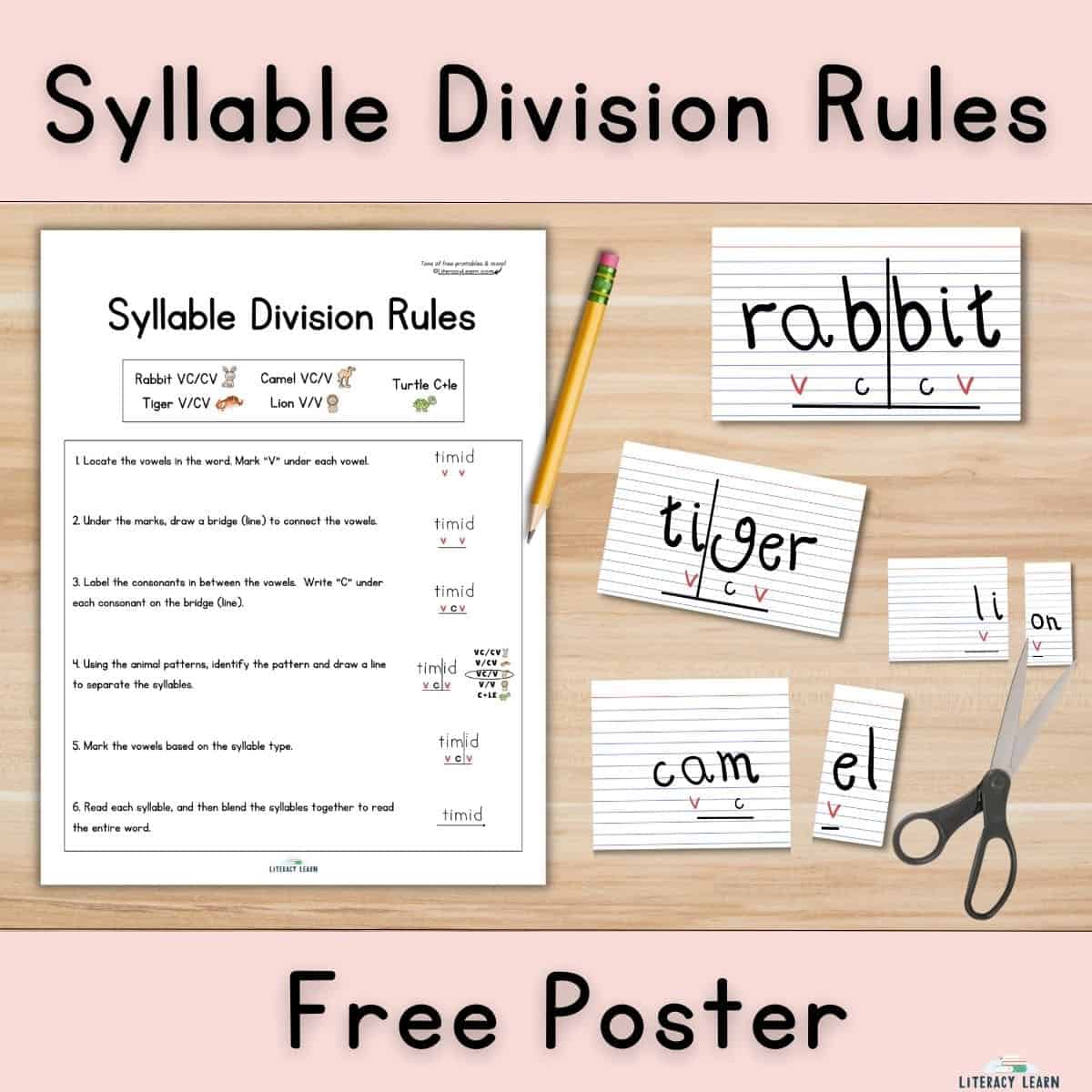
What Is Syllabication?
Syllabication is breaking words apart into syllables. We sometimes refer to this as ‘chunking words.’ We do this in order to read longer words accurately.
Using syllabication, children see an unfamiliar word, break it into separate syllables, and decode each syllable individually. Then they blend the syllables together to read the entire word.
This is helpful for kids as they transition to reading longer, more complex words, and many curriculums and programs rooted in Orton-Gillingham methodology include syllabication as a reading strategy.
This includes our favorite structured literacy platform, Lexercise, where we learned all about syllabication in the Orthography unit.
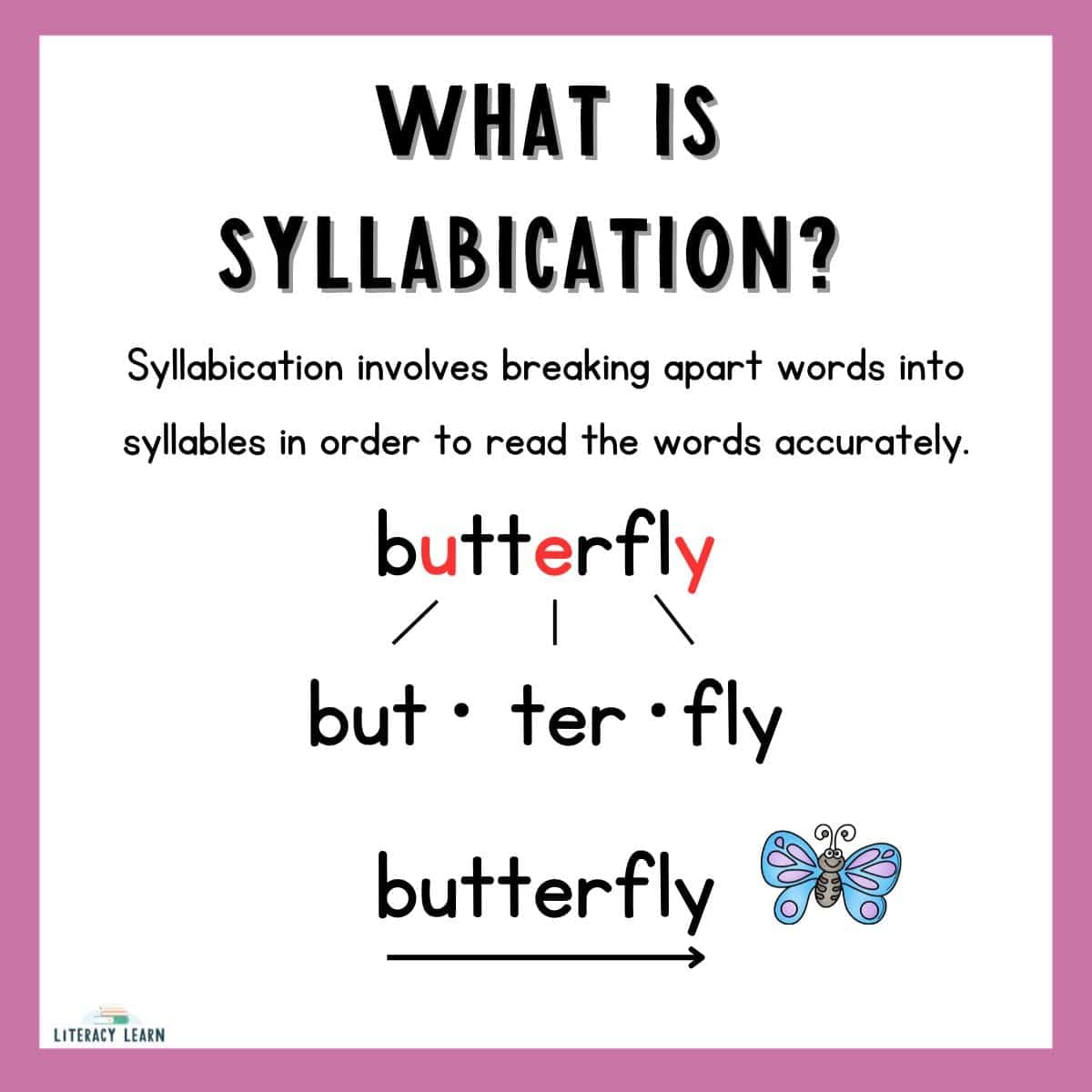
6 Syllable Types
Before discussing syllable division patterns and rules, it’s important that we have a basic understanding of syllables and syllable types in English. The syllable type may help determine the sound of the vowel.
The Six Syllable Types are:
- Closed Syllables
- Open Syllables
- VCe (Magic E) Syllables
- R-Controlled Syllables
- Vowel Team Syllables
- Consonant+le Syllables
Read more about each syllable type, get some practical resources for teaching each of the 6 Syllable Types, and grab a free syllable types anchor chart.

Syllable Division Rules
Once kids learn a few syllable types (beginning with open and closed), they can begin learning the syllable division rules.
There are patterns in words that help us to divide syllables appropriately and read words accurately. Knowing these patterns will help children to correctly pronounce each syllable.
To make these patterns memorable, we assign each pattern with an animal name that matches the patterns.
- 🐰 Rabbit Words: Words that follow the VC/CV pattern.
- 🐯 Tiger Words: Words that follow the V/CV pattern.
- 🐫 Camel Words: Words that follow the VC/V pattern.
- 🦁 Lion Words: Words that follow the V/V pattern.
- 🐢 Turtle Words: Words that include a Consonant+le pattern at the end.
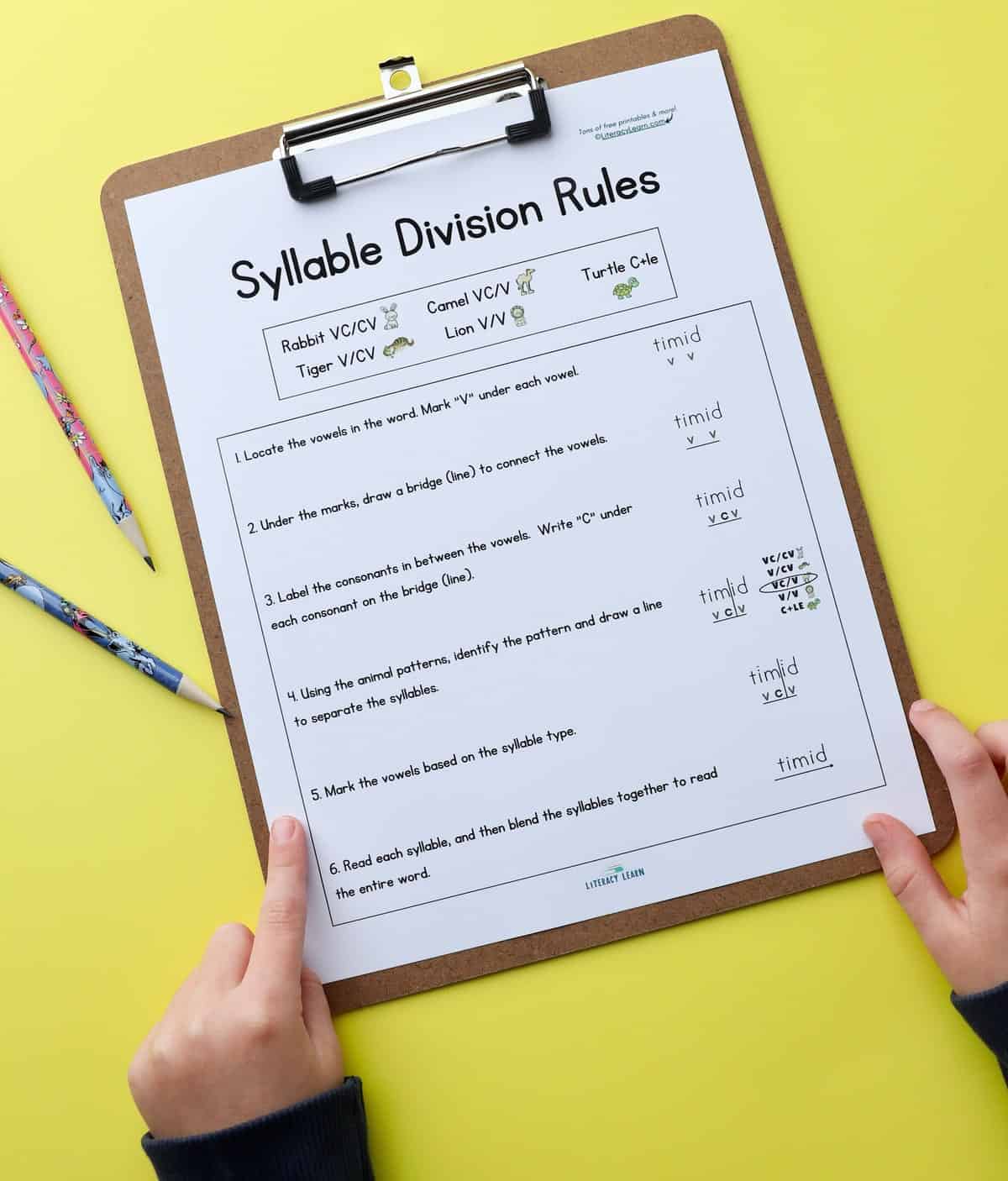
Procedure
Then, we teach kids the same procedure for dividing any word they come across!
Here’s how to divide words into syllables:
- Locate the vowels in the word. Mark “V” under each vowel.
- Under the marks, draw a bridge (line) to connect the vowels.
- Label the consonants in between the vowels. Write “C” under each consonant on the bridge (line).
- Using the animal patterns, identify the pattern and draw a line to separate the syllables.
- Mark the vowels based on the syllable type.
- Read each syllable, and then blend the syllables together to read the entire word.
👌🏼 Pro-Tip: Don’t worry about labeling (or marking) any letters that come before the first vowel or after the last vowel. These letters have no impact on the vowel sounds, and it makes it look way too cluttered.
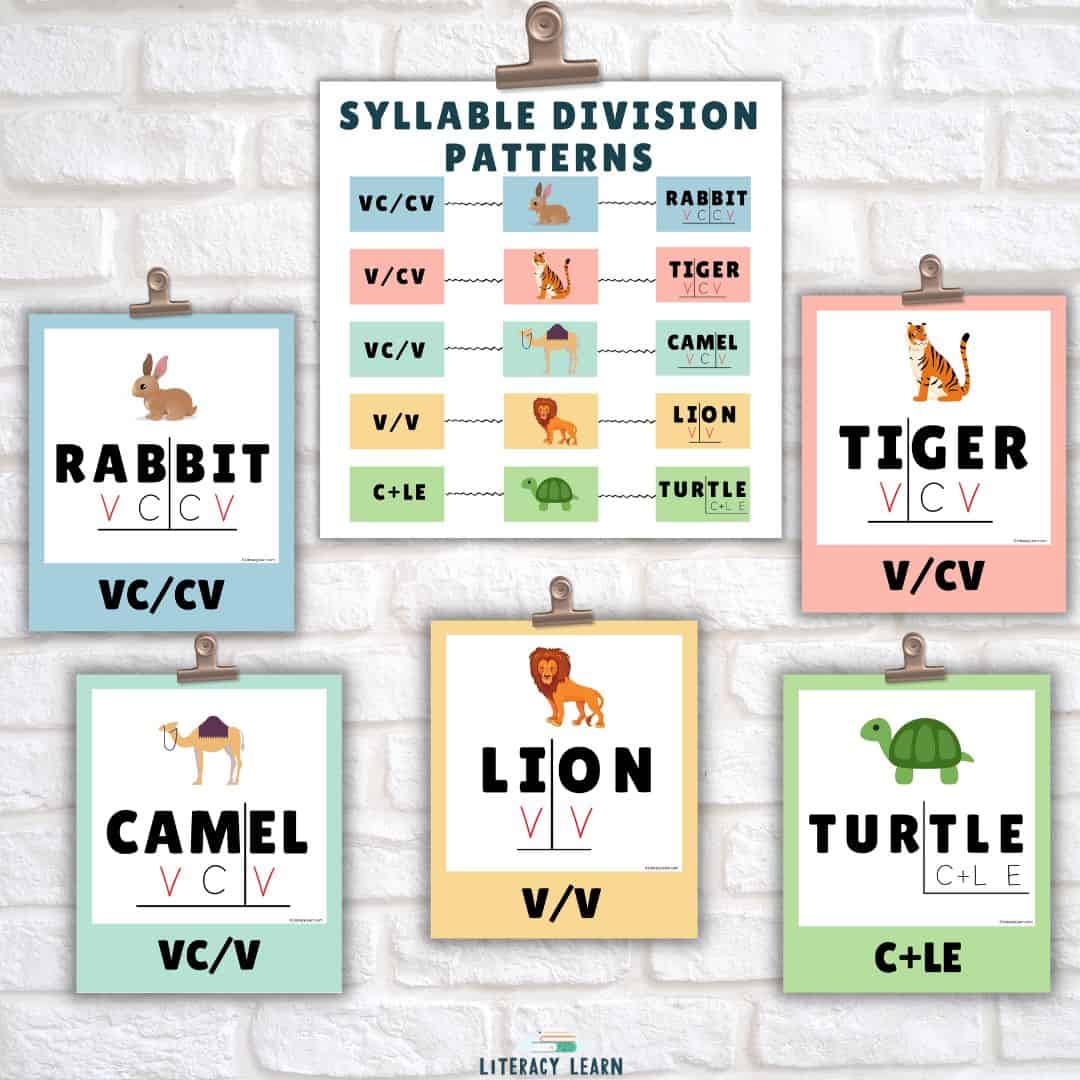
VC/CV Rule: Rabbit Rule 🐰
The VC/CV rule is the syllable division rule to teach when moving kids from one-syllable to two-syllable words. Do this once kids have mastered reading closed-syllable and nonsense words. This usually happens in early first grade.
🐇 Rabbit Rule: When two consonants come between two vowels, divide between the consonants.
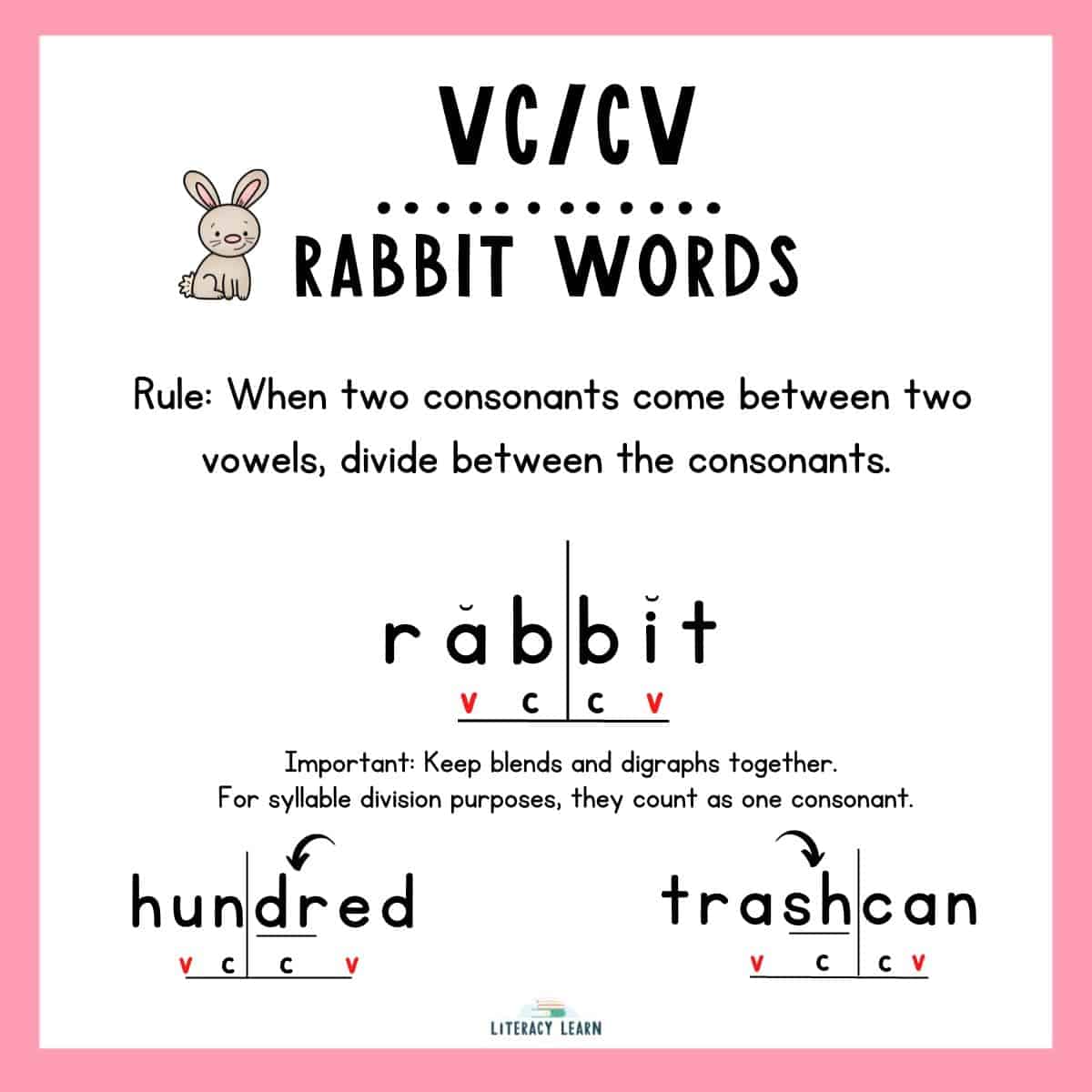
Put on your rabbit ears and teach kids how easy it can be to divide these words between the two consonants.
Using the procedure listed above, kids should identify these words as CV/CV words.
Since syllable division is totally new for students, you can teach it like this:
- Start by using words that include the same middle consonant, like rab/bit, bon/net, ten/nis, and muf/fin.
- Then, move to words with different middle consonants, like cac/tus, fab/ric, gob/lin, and nap/kin. You can also include compound words here, like bat/man, sun/set, bed/rock, and cat/fish.
- Next, introduce the important concept that kids MUST keep digraphs and blends together – they count as one “C.” This is seen in words like im/press, ank/let, pil/grim, fish/net, and hun/dred.
Grab 4 free pdf word lists with 83 Rabbit words to help students practice!
Important: In many two-syllable words, the schwa sound will be heard in the second syllable. Teach this so kids can be flexible in reading schwa sound words with the correct pronunciation.
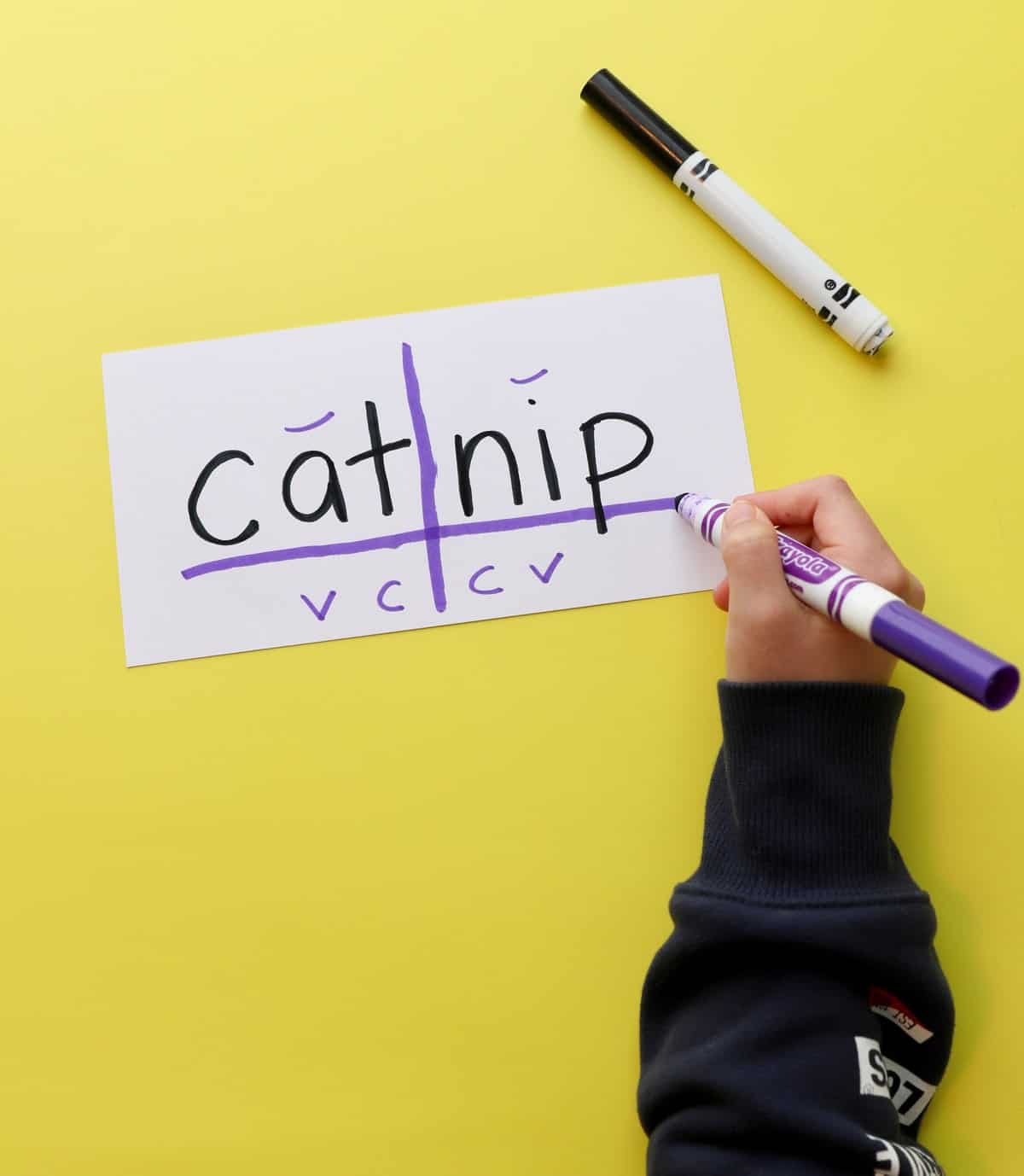
V/CV & VC/V Rules: Tiger & Camel Rule 🐯🐪
These two patterns will expand students’ ability to read multisyllabic words.
Introduce the Tiger and Camel patterns together. You’ll notice that in both of these patterns, one consonant is between two vowels.
The questions become: Where do we divide? Will the word follow the V/CV pattern or the VC/V pattern? How will kids know which sound the vowel is going to make?
It’s quite simple: Try Tiger first. If that doesn’t work, try Camel.
Teach them these rules:
🐯 Tiger Rule: When one consonant comes between two vowels, try dividing after the first vowel to create an open syllable (long vowel).
🐪 Camel Rule: When one consonant comes between two vowels, and the V/CV does not make a real word, try dividing after the consonant to create a closed syllable (short vowel).
The reason we teach kids to try the Tiger rule first, pronouncing the first vowel as a long vowel, is because approximately 75% of VCV words will be divided as tiger words (V/CV).
Only 25% of words will be divided as camel words (VC/V). So we try the most probable sound first.
Kids must demonstrate that they can flex between the two patterns. For example:
- pilot: pi/lot or pil/ot? Which is the real word?
- rapid: ra/pid or rap/id? Which is the real word?
Kids’ knowledge of vocabulary words is super important here! If kids don’t know the word, they won’t be able to recognize how to divide the word to pronounce it correctly.
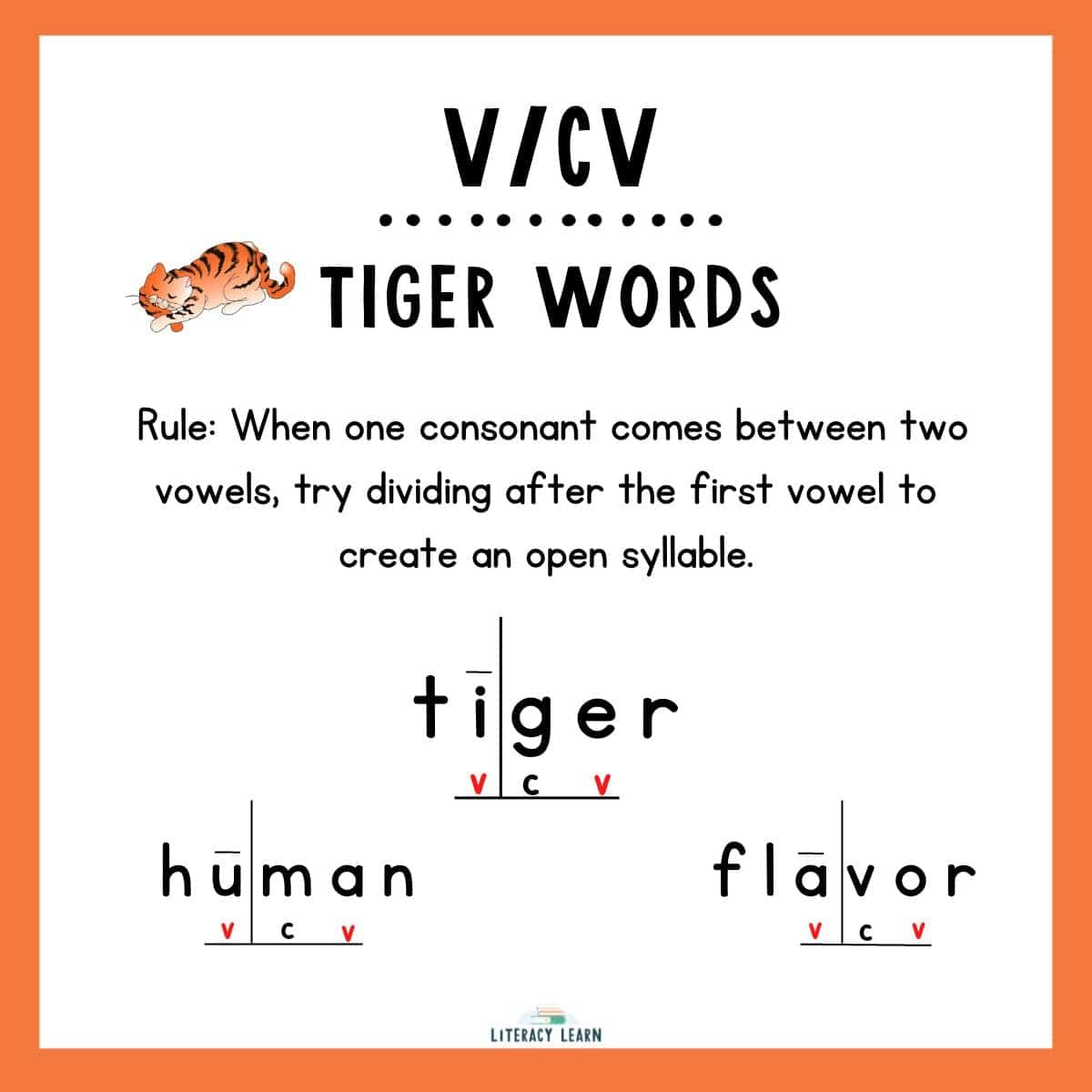
Tiger Word Examples:
- la/zy
- vi/tal
- po/ny
- ba/con
- la/bor
- mu/sic
- Fri/day
- ru/ler
Camel Word Examples:
- reb/el
- stud/y
- top/ic
- lev/el
- vis/it
- clin/ic
- pan/ic
- met/al
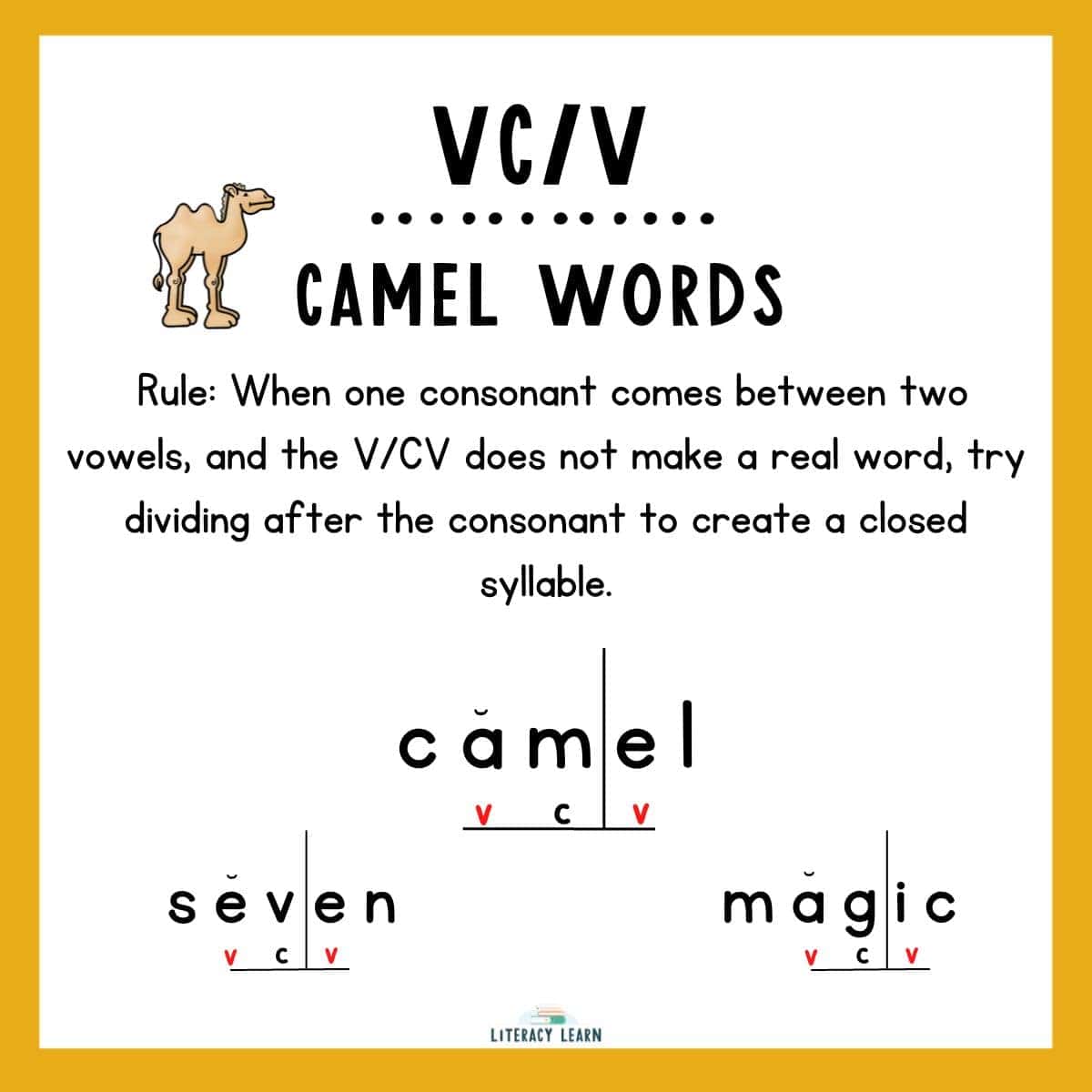
V/V Rule: Lion Rule 🦁
Continue teaching this syllable division rule once kids know the common vowel teams. This will be important since kids need to know whether to divide the vowels, or whether the vowels are a part of vowel digraphs (teams).
🦁 Lion Rule: If the two vowels next to each other are NOT a vowel team or vowel digraph, look for the V/V pattern and divide between the two vowels.
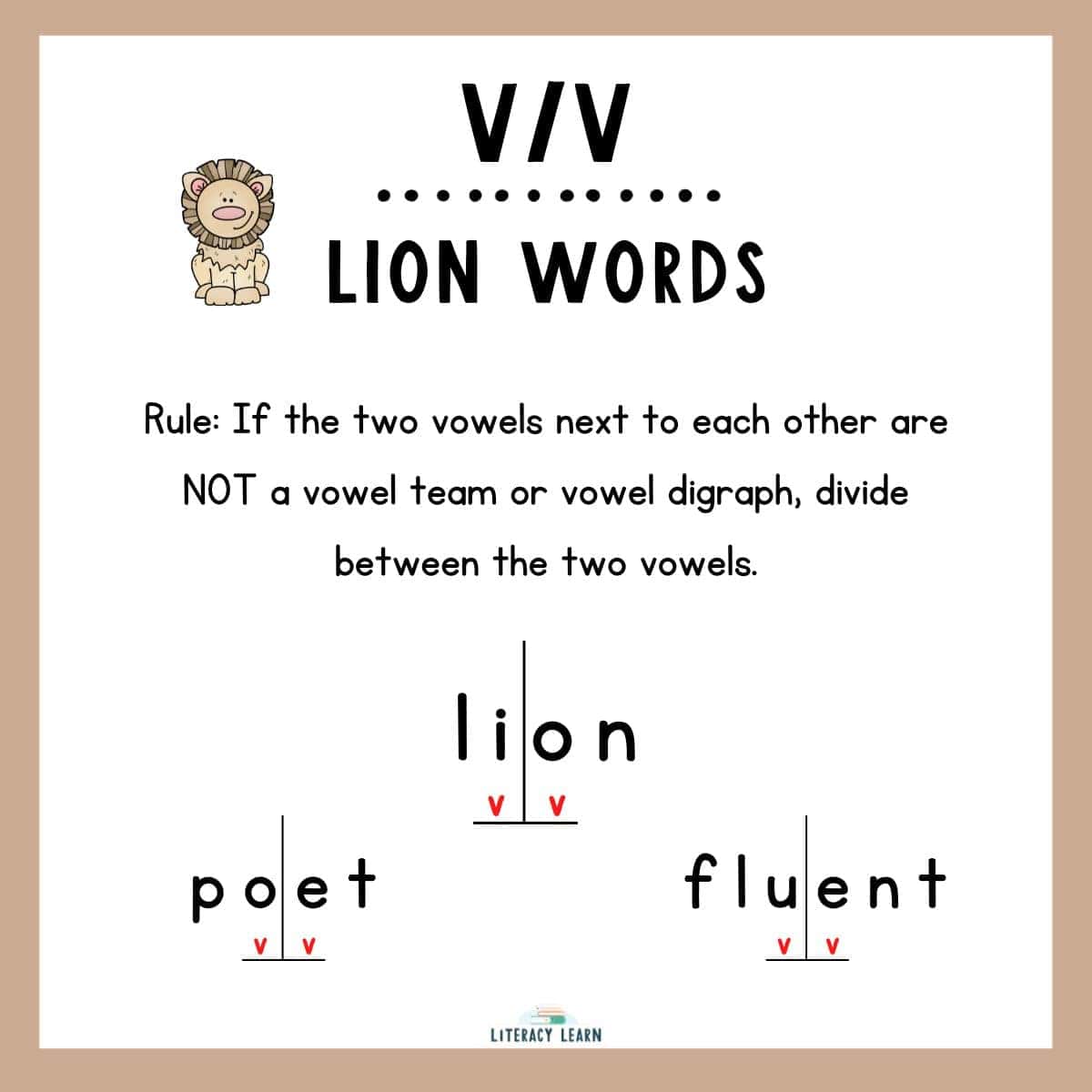
Using the procedure listed above, kids should identify these words as V/V words. In lion words, each vowel is going to have its own unique sound, like in li/on, ri/ot, po/et, and flu/ent.
When dividing, you’ll notice an open syllable with a long vowel sound will come first, since no consonant is closing it in.
Lion Word Examples:
- flu/id
- cha/os
- i/on
- Bu/ick
- di/et
- ro/deo
- vi/o/lin
- tru/ant
C+le Rule: Turtle Rule 🐢
This pattern is an important one because so many words include a C+le syllable. We call these words turtle words.
🐢 Turtle Rule: In a word ending with a consonant + le, count back three letters from the end to divide the word.
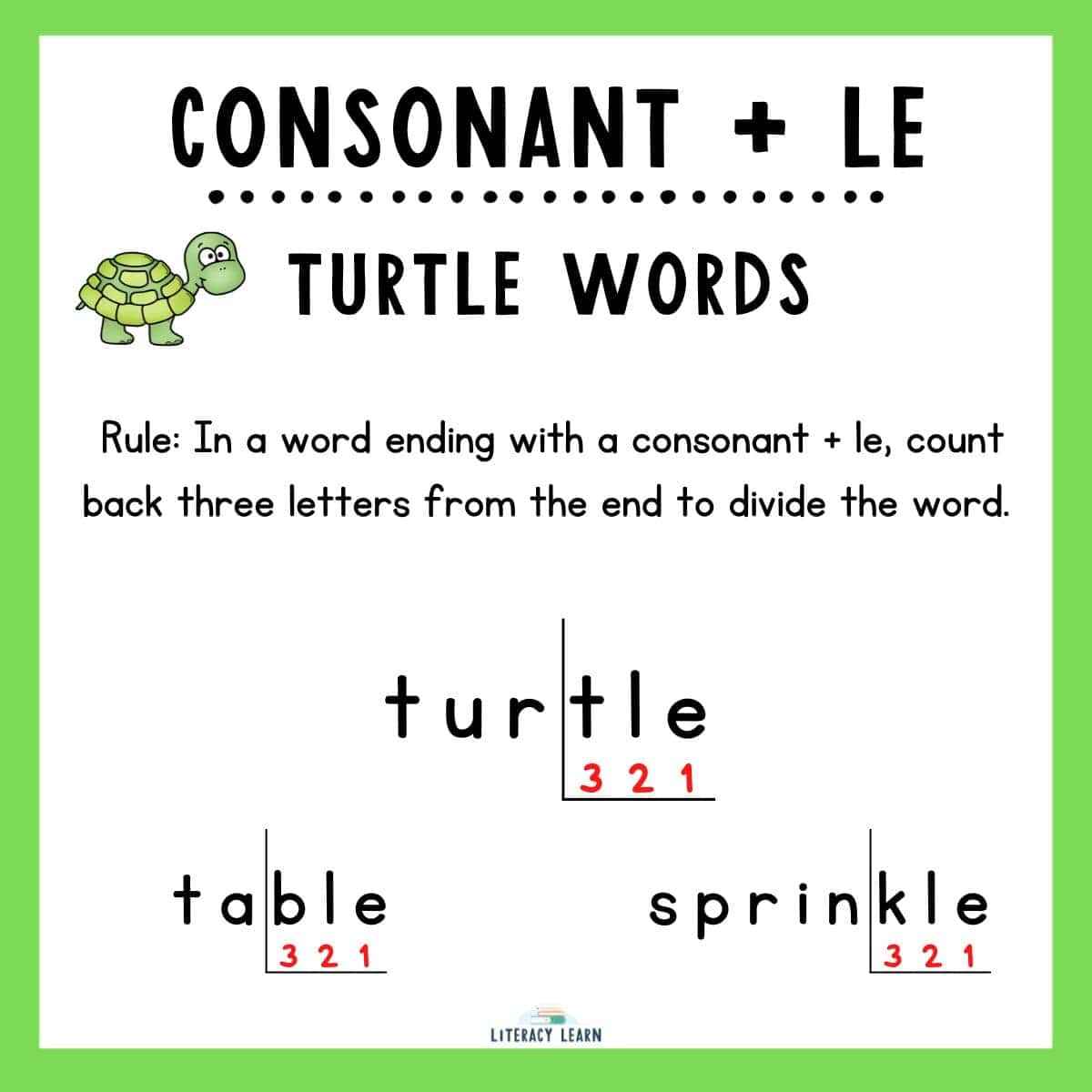
A catchy jingle you might teach your students to chant is – “Consonant-LE, count back 3.”
The “E” is added to the end of the syllable to make sure that the syllable includes a written vowel, which is one of the final silent E jobs.
Turtle Word Examples:
- an/gle
- puz/zle
- gig/gle
- bot/tle
- scram/ble
- sta/ble
- fic/kle
📃 Looking for more words? Grab 2 pdf word lists with 141 C+le words to help students practice!
Syllabication Worksheets
We have created a resource with 20+ worksheets to help your students master syllable division – all for under $2!
Visit our TPT store to grab this amazing no-prep resource to make teaching syllabication easy. It includes 3 worksheets for each syllable division rule explained in this post.
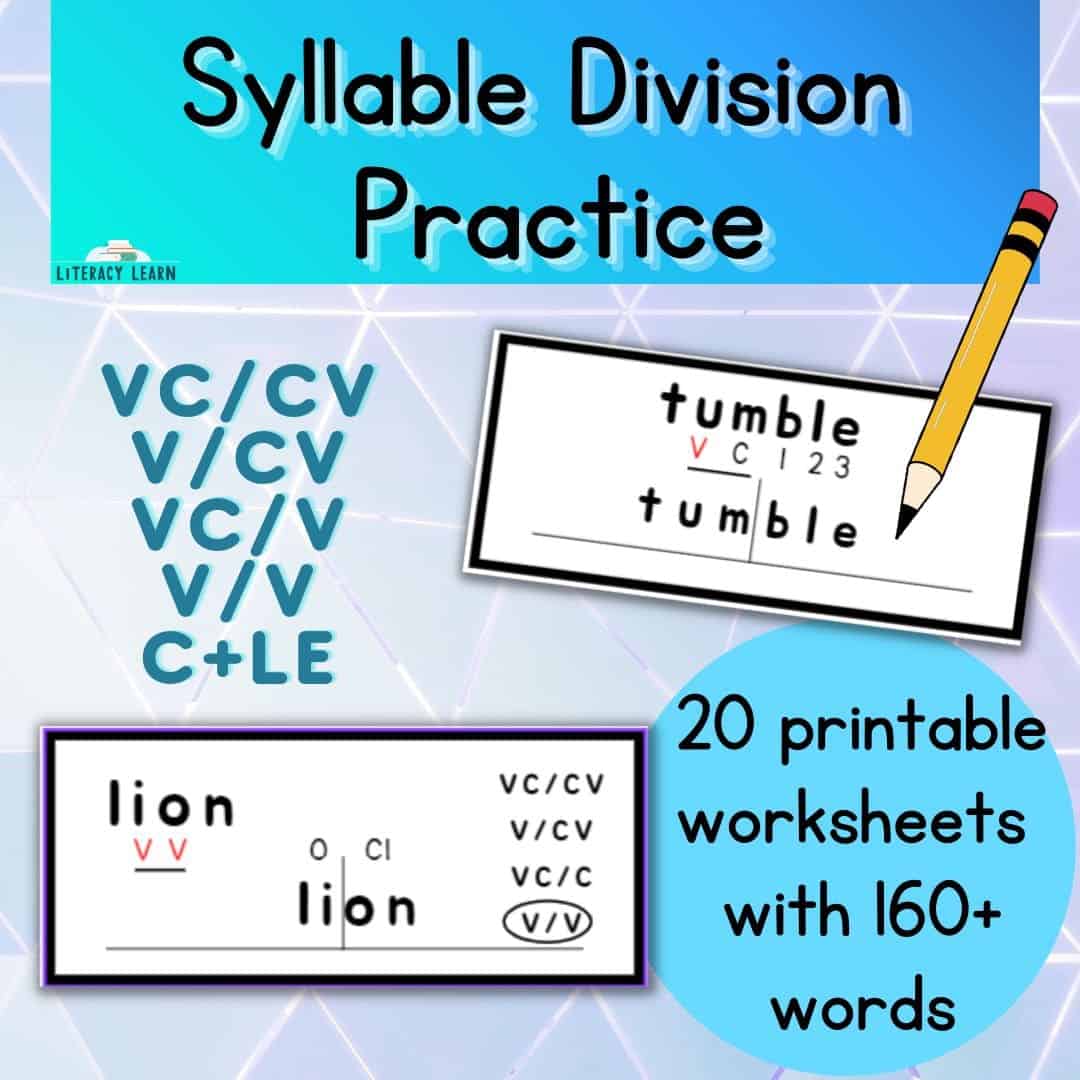
Why Teach Syllabication?
As a final note, you may be wondering, why teach syllabication? It seems like A LOT for kids to wrap their minds around.
We teach basic syllabication because multiple studies have shown that it helps kids decode words. These various studies conclude that syllabication can support readers as they use syllables to analyze and read words. It can be another useful tool in a reader and writer’s toolbox.
But, there has also been pushback because many syllables may not be stable, or actually follow the rules. These “rules” may not be applied in some words. So we need to teach using a level of flexibility or set for variability.
Research has shown that syllabication should be taught in conjunction with morphology to be most impactful. This combination helps kids become aware of and analyze words for morphemes (smallest units of meanings), like prefixes, roots, suffixes, and inflectional endings. Most experts agree that when combined, these two tools can help kids read bigger words more effectively.
To read some of the research:
- Bhattacharya, A., & Ehri, L. C. (2004). Graphosyllabic analysis helps adolescent struggling readers read and spell words. Journal of Learning Disabilities, 37, 331–348.
- Moats, L. C. (2004b). Efficacy of a structured, systematic language curriculum for adolescent poor readers. Reading and Writing Quarterly, 20,145–159.
- Muller et al. (2020). Syllable-based reading improvement: Effects on word reading and reading comprehension in Grade 2 Journal of Learning & Instruction, 66.
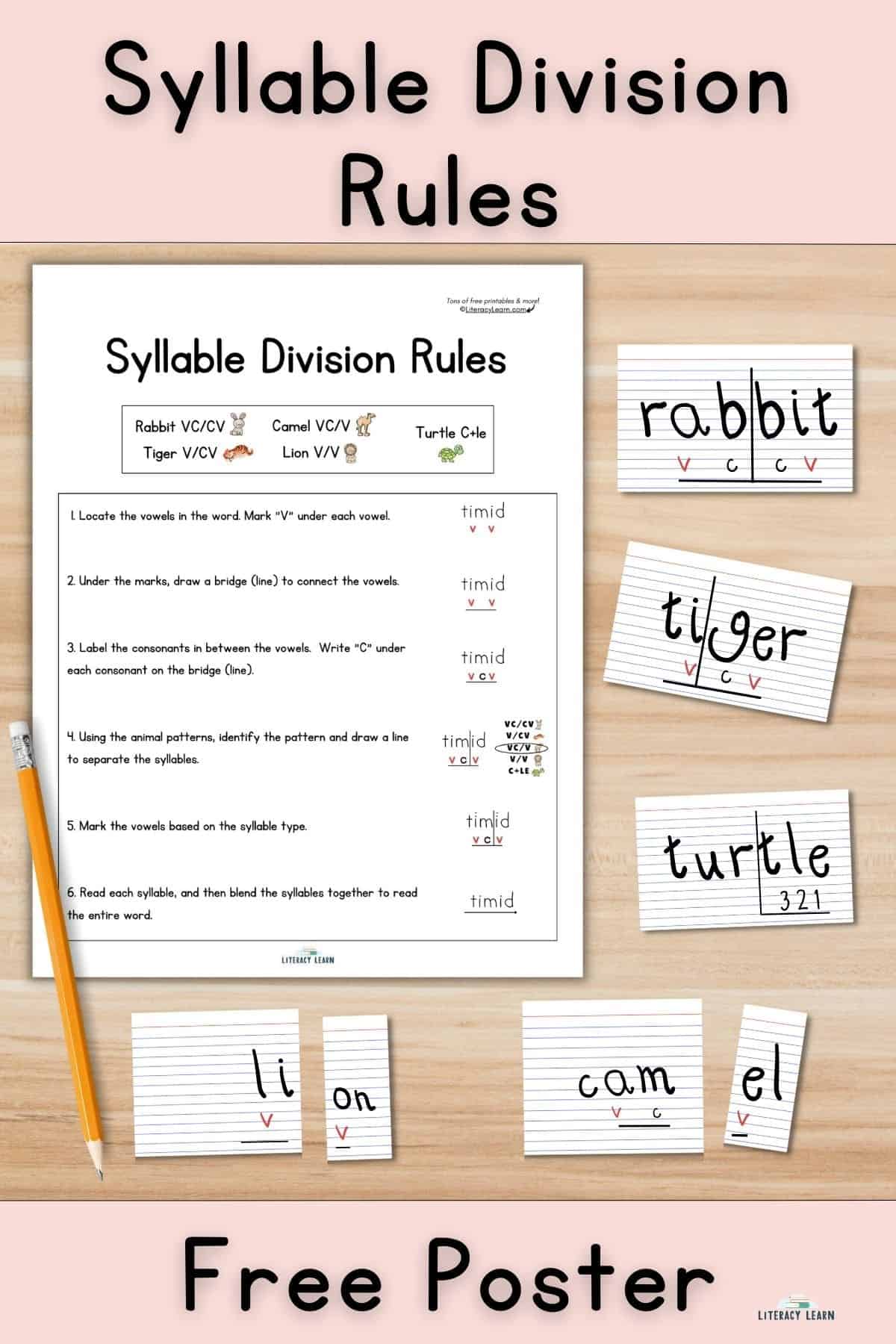
Download & Print
Do you teach syllable division? What success have you had with your students? Please comment below or tag us on Instagram @Literacylearn to tell us your best tips for teaching blending.
DOWNLOAD TERMS: All of our resources and printables are designed for personal use only in homes and classrooms. Each teacher must download his or her own copy. You may not: Save our files to a shared drive, reproduce our resources on the web, or make photocopies for anyone besides your own students. To share with others, please use the social share links provided or distribute the link to the blog post so others can download their own copies. Your support in this allows us to keep making free resources for everyone! Please see our Creative Credits page for information about the licensed clipart we use. If you have any questions or concerns regarding our terms, please email us. Thank you!

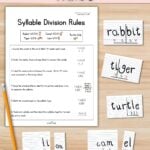
This is a complete package!!!
So direct and clear and simple.
You remain the best. Teaching syllables has never been this easy!!!
Keep up the good work.
Bravo!
Hi Sarah,
We’re so happy that our resources have made your teaching easier 😉 That’s what it’s all about here at Literacy Learn.
XO Katie and Laura
Thank you. I like your chart a great deal. I have always used the marking of vowels, but never underlined between the vowels to connect them. This makes total sense as this is where the student must always flex to decide which syllable the consonant will go with. Great idea!
Hi Pamela,
Thank you for the feedback. We’re so pleased to hear that you learned something new and helpful concerning syllable division.
Katie & Laura
Thank you! This will be great for my older students who struggle with decoding.
Morgane,
So glad to know you can use it with your older students!
Katie and Laura
Thank you so much! I am a reading coach and have been using your Syllabication methods with the 2nd and 3rd grade students that I take for intervention. They are coming up to me and thanking me for teaching them. They are telling how much they use the skill in their AR reading. Thank you for making such a difference in the lives of teachers and students.
Jeneane,
We are so glad to hear how teaching your students syllabication has equipped them to be able to read longer, more complex words! We love this!!! Keep up the excellent work 😉
Katie and Laura